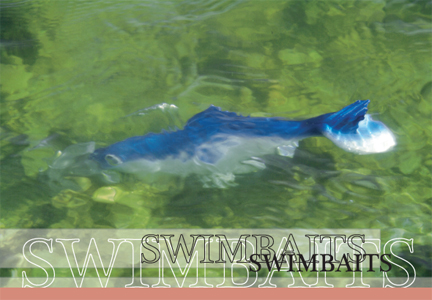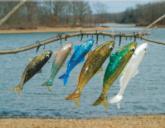Swimbaits
3- to 7-pound lunkers agree, it's what's for dinner

It sails like a rocket and crashes into the water like a mortar shell, but few baits attract more monster fish than a swimbait.
“I started fishing swimbaits during a tournament in California,” said pro Kevin VanDam from Kalamazoo, Mich. “The first bass I caught with a swimbait weighed 9 pounds, 13 ounces. I was hooked. I’ll carry swimbaits now until forever because I’ve seen how powerful they are as a draw for bass.”
Swimbaits come in two basic configurations. Some come equipped with internal lead weights packed in soft, natural-looking bodies. Dangling tails create tempting side-to-side action while internal weights produce enticing wobbles in falling baits. Others employ external jigheads with detachable soft-plastic tails to provide the temptation. Swimbaits range in size from 2 inches long to more than 10 inches in length and may weigh up to 2 ounces.
“It’s a big-fish technique for sure,” VanDam said. “It’s not a numbers bait. With swimbaits, anglers target bass weighing at least 3 pounds. It’s a phenomenal bait to use in a lake with a lot of 3- to 7-pound fish.”
 For decades, saltwater anglers tempted redfish, spotted sea trout, cobia, king mackerel and other species with various types of swimbaits. They remain popular among saltwater anglers, but bass fanatics also discovered that the big, realistic baits entice lunker bucketmouths.
For decades, saltwater anglers tempted redfish, spotted sea trout, cobia, king mackerel and other species with various types of swimbaits. They remain popular among saltwater anglers, but bass fanatics also discovered that the big, realistic baits entice lunker bucketmouths.
Anglers can catch big bass on such baits in virtually any lake where lunker largemouths lurk. The technique works best in a lake with a combination of big bass, abundant large forage fish – such as gizzard or large threadfin shad, tilapia, or stocked trout – and deep, relatively clear water.
Bass anglers first employed big swimbaits in the legendary lunker lakes of California and other places out West. However, Southern sportsmen also began using the baits in lakes with high populations of threadfin or gizzard shad. A gizzard shad may grow to 12 inches long or more, and a bass weighing 5 pounds or more can easily swallow a 6-inch shad.
Since these baits stimulate fish mostly by sight, lunkers need to see the bait to strike. Anglers should use them in water with at least 3 feet of visibility. They probably would not work effectively in muddy rivers. Additionally, a 1-ounce bait sinks rapidly, so such a large bait would probably not work as well in shallow water.
Swimbaits work exceptionally well off long points that drop off sharply into deep water. Fish may meander back and forth across the point, drop into the depths, or feed in the shallows. Often, bass suspend just over the drop-off edge. Around these deeper points, let swimbaits sink to the bottom. Then crawl them back to the boat extremely slowly, just off the bottom.
Many anglers use them in flooded timber standing in water perhaps 15 to 30 feet deep. Bass often suspend around standing trees and other vertical cover. Depending upon the speed of the retrieve, an angler can work a swimbait at various levels from the bottom to just under the surface.
 With a fast retrieve, almost like a crankbait, swimbaits run about 1 to 5 feet beneath the surface. With a slow, barely moving retrieve, baits seemingly hover just over the bottom. An intermediate retrieve puts the bait in the 5- to 20-foot range.
With a fast retrieve, almost like a crankbait, swimbaits run about 1 to 5 feet beneath the surface. With a slow, barely moving retrieve, baits seemingly hover just over the bottom. An intermediate retrieve puts the bait in the 5- to 20-foot range.
“I fish a heavy swimbait in deep water, like off points and humps,” VanDam said. “I also fish it through standing timber, almost like slow-rolling a spinnerbait. It draws bass out of thick cover. It looks like an easy meal, so bass come out to get it. The swimming-action tails give it quite a bit of vibration.”
Anglers can also “worm” baits over the bottom. For “worming,” let a bait hit bottom or the tops of submerged grass a few times to make a little disturbance. Slowly bounce it along the bottom like a worm or jig with a pause-and-go method. This works best with finicky or lethargic bass.
Anglers can also vertically jig large swimbaits to probe deep holes off points, next to drop-offs or around the edges of humps and ledges. The heavy baits sink quickly. Simply bounce them off the bottom. Lift them about 3 or 4 feet and let them drop naturally.
Bass often hit lures or natural forage on the fall. They might strike a baitfish to kill it but not eat it. Then they return to suck up the dying fish as it flutters down. Few bass can resist slurping a shad or similar baitfish dropping helplessly.
“A lot of fish follow a swimbait,” VanDam said. “The action is mesmerizing. During practice for tournaments, I find a lot of fish with swimbaits. On my best day with a swimbait, I actually didn’t catch a fish. I used one without a hook during practice to find fish. I could have caught a lot of fish on it that day.”
If bass follow or hit swimbaits without gulping them, stop retrieving to allow baits to sink briefly. Baits flutter down, almost like dying shad.
 Sometimes, fish hit aggressively and gulp baits. More often, bass simply inhale them. Since soft-plastic baits feel like live fish, bass may hold them in their mouths for a time. Anglers might only feel a slight tap, like a bass nibbling a plastic worm. Often, anglers only feel a slight heaviness as if a lure has snagged on submerged grass. If anglers feel a tap, they should not set the hook until they can feel the weight of the fish or movement on the line.
Sometimes, fish hit aggressively and gulp baits. More often, bass simply inhale them. Since soft-plastic baits feel like live fish, bass may hold them in their mouths for a time. Anglers might only feel a slight tap, like a bass nibbling a plastic worm. Often, anglers only feel a slight heaviness as if a lure has snagged on submerged grass. If anglers feel a tap, they should not set the hook until they can feel the weight of the fish or movement on the line.
Big baits require big tackle
When people throw big swimbaits, they look for big fish. They might only expect a handful of bites per day, so they need to make every bite count.
Big baits targeted at big fish in deep water require tackle up to the job. Many pros recommend using a rod with plenty of backbone and line strong enough to keep a lunker under control. A heavy-action 6 1/2-foot rod with 20-pound-plus line is a popular setup.
Many anglers use braided line for its strength, but sometimes braided lines can spook fish in super-clear water where swimbaits work best. To remedy this, attach an 18- to 36-inch section of fluorocarbon leader to the end of the braided line.
Fluorocarbon line becomes almost invisible in water but can become difficult to cast. Braided line gives the rig strength and casting ability while the fluorocarbon leader will not spook finicky lunkers. Moreover, if anglers snag on the bottom, they can usually break the fluorocarbon leader instead of cutting a long section of braided line at water level.